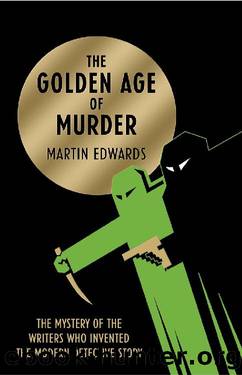The Golden Age of Murder (2015) by Martin Edwards

Author:Martin Edwards [Edwards, Martin]
Language: eng
Format: epub
Publisher: HarperCollins Publishers
Published: 2015-04-08T21:00:00+00:00
Notes to Chapter 16
how to encode and decode a Playfair cipher
The Playfair cipher was devised by Charles Wheatstone (who also invented the Wheatstone bridge, which measures electrical resistance) and was named after Lyon Playfair, 1st Baron Playfair of St Andrews, whom Wheatstone introduced to the technique in 1850. Put simply, the Playfair cipher encrypts pairs of letters (digraphs) rather than single letters, as in the more straightforward âsubstitution ciphersâ favoured by Edgar Allan Poe, Arthur Conan Doyle and other crime writers. For a detailed account of the help Rhode supplied to Sayers, see Peter Ibbotson, âSayers and Ciphersâ, Cryptologia 25 (April 2001).
other poets such as ⦠Edward Shanks
Edward Shanks (1892â1953), first winner of the Hawthornden Prize, earned acclaim as a war poet, literary critic and journalist. He wrote a biography of Poe, and occasionally veered towards an unorthodox brand of mystery in his fiction, notably with Old King Cole (1936).
an abortive mystery novel of his own that was never published in his lifetime
The Death of the Kingâs Canary, co-written with John Davenport, eventually appeared in 1977. Thomas wanted the book to be âthe detective story to end detective stories, introducing blatantly every character and situation â an inevitable Chinaman, secret passages, etc. â that no respectable writer would dare use nowâ.
Virginia Woolfâs husband Leonard
The Woolfs ran the Hogarth Press, and occasionally published novels of crime and detection, including The Case is Altered (1932), the most memorable book by William Plomer (1903â73). Plomer based the story upon a wife-murder committed in a London boarding house where he happened to be living. As well as writing novels and poetry, Plomer was a literary editor, and Ian Fleming dedicated Goldfinger to him. The Woolfs also published Clifford Henry Benn Kitchin (1895â1973), a barrister, stockbroker, pianist, bridge and chess player, rare book collector, greyhound owner, and gambler with a private fortune. Kitchinâs early work attracted comparisons with Aldous Huxley, but today he remains known mainly for his mysteries; like Chesterton and the Coles, he would never have anticipated such a fate. His finest novel in the genre is, arguably, the unaccountably neglected Birthday Party (1938), and he was considered for considered for membership of the Detection Club shortly after war broke out. Kitchinâs Crime at Christmas (1934) ends with a âShort Catechismâ in which the stockbroker sleuth Malcolm Warren says: âThe excuse for a detective story is two-fold. First, it presents a problem to be solved and shares, in a humble way, the charm of the acrostic and the crossword puzzle. But secondly â and this, to my mind, is its real justification â it provides one with a narrow but intensive view of ordinary life, the steady flow of which is felt more keenly through the very violence of its interruption.â
the feminist writer Rose Macaulay
Dame Emilie Rose Macaulay (1881â1950) enjoyed a distinguished literary career. Mystery at Geneva: An Improbable Tale of Singular Happenings (1922) is a minor work set in the near future, and is as notable for its social commentary as the mystery element.
Download
This site does not store any files on its server. We only index and link to content provided by other sites. Please contact the content providers to delete copyright contents if any and email us, we'll remove relevant links or contents immediately.
4 3 2 1: A Novel by Paul Auster(12214)
The handmaid's tale by Margaret Atwood(7637)
Giovanni's Room by James Baldwin(7115)
Asking the Right Questions: A Guide to Critical Thinking by M. Neil Browne & Stuart M. Keeley(5577)
Big Magic: Creative Living Beyond Fear by Elizabeth Gilbert(5555)
Ego Is the Enemy by Ryan Holiday(5226)
The Body: A Guide for Occupants by Bill Bryson(4886)
On Writing A Memoir of the Craft by Stephen King(4820)
Ken Follett - World without end by Ken Follett(4596)
Adulting by Kelly Williams Brown(4436)
Bluets by Maggie Nelson(4430)
Eat That Frog! by Brian Tracy(4381)
Guilty Pleasures by Laurell K Hamilton(4279)
The Poetry of Pablo Neruda by Pablo Neruda(3989)
Alive: The Story of the Andes Survivors by Piers Paul Read(3922)
White Noise - A Novel by Don DeLillo(3915)
Fingerprints of the Gods by Graham Hancock(3898)
The Book of Joy by Dalai Lama(3855)
The Bookshop by Penelope Fitzgerald(3720)
